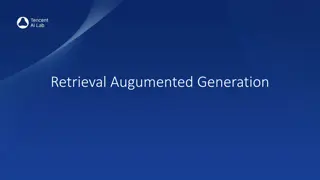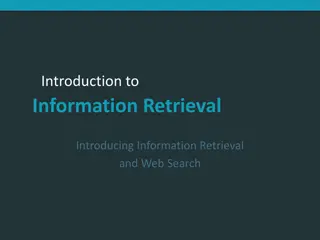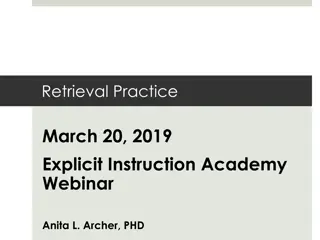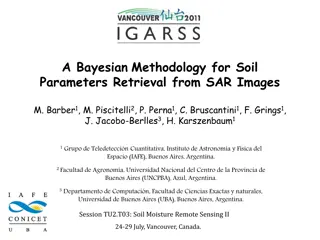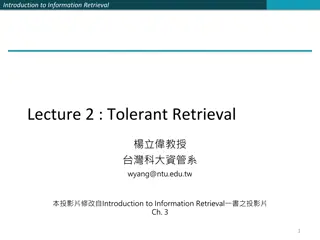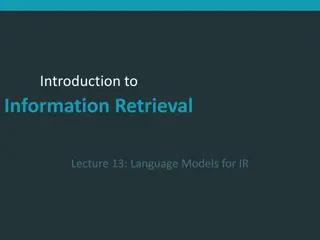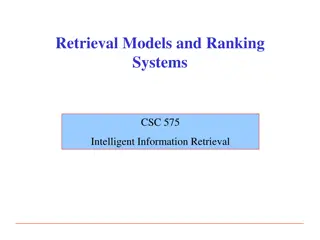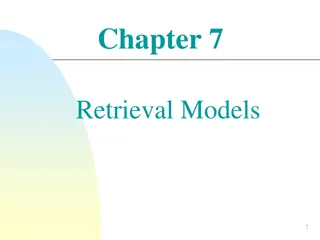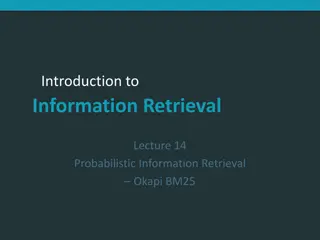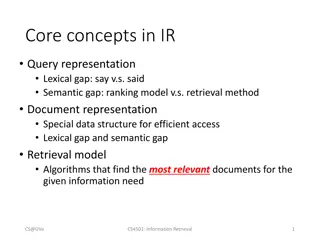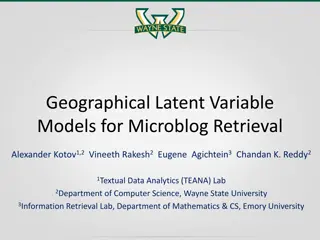Information Retrieval Models and Processes
Delve into the world of information retrieval models with a focus on traditional approaches, main processes like indexing and retrieval, cases of one-term and multi-term queries, and the evolution of IR models from boolean to probabilistic and vector space models. Explore the concept of IR models, representation of documents and queries, and ranking functions. Gain insights into early IR models like Coordinate Matching Score and the importance of term weighting.
Uploaded on Sep 15, 2024 | 1 Views
Download Presentation

Please find below an Image/Link to download the presentation.
The content on the website is provided AS IS for your information and personal use only. It may not be sold, licensed, or shared on other websites without obtaining consent from the author.If you encounter any issues during the download, it is possible that the publisher has removed the file from their server.
You are allowed to download the files provided on this website for personal or commercial use, subject to the condition that they are used lawfully. All files are the property of their respective owners.
The content on the website is provided AS IS for your information and personal use only. It may not be sold, licensed, or shared on other websites without obtaining consent from the author.
E N D
Presentation Transcript
Traditional IR models Jian-Yun Nie
Main IR processes Last lecture: Indexing determine the important content terms Next process: Retrieval How should a retrieval process be done? Implementation issues: using index (e.g. merge of lists) (*) What are the criteria to be used? Ranking criteria What features? How should they be combined? What model to use? 2
Cases one-term query: The documents to be retrieved are those that include the term - Retrieve the inverted list for the term - Sort in decreasing order of the weight of the word Multi-term query? - Combining several lists - How to interpret the weight? - How to interpret the representation with all the indexing terms for a document? (IR model) 3
What is an IR model? Define a way to represent the contents of a document and a query Define a way to compare a document representation to a query representation, so as to result in a document ranking (score function) E.g. Given a set of weighted terms for a document Should these terms be considered as forming a Boolean expression? a vector? What do the weights mean? a probability, a feature value, What is the associated ranking function?
Plan This lecture Boolean model Extended Boolean models Vector space model Probabilistic models Binary Independent Probabilistic model Regression models Next week Statistical language models
Early IR model Coordinate matching score (1960s) Matching score model Document D = a set of weighted terms Query Q = a set of non-weighted terms R(D,Q)= w(ti,D) ti Q Discussion Simplistic representation of documents and queries The ranking score strongly depends on the term weighting in the document If the weights are not normalized, then there will be great variations in R 6
IR model - Boolean model Document = Logical conjunction of keywords (not weighted) Query = any Boolean expression of keywords R(D, Q) = D Q D1= t1 t2 t3 D2= t2 t3 t4 t5 Q = (t1 t2) (t3 t4) e.g. (the three terms appear in D) D1 Q, thus R(D1, Q) = 1. but D2 Q, thus R(D2, Q) = 0. / 7
Properties Desirable R(D,Q Q)=R(D,Q Q)=R(D,Q) R(D,D)=1 R(D,Q Q)=1 R(D,Q Q)=0 Undesirable R(D,Q)=0 or 1
Boolean model Strengths Rich expressions for queries Clear logical interpretation (well studied logical properties) Each term is considered as a logical proposition The ranking function is determine by the validity of a logical implication Problems: R is either 1 or 0 (unordered set of documents) many documents or few/no documents in the result No term weighting in document and query is used Difficulty for end-users for form a correct Boolean query E.g. documents about kangaroos and koalas kangaroo koala ? kangaroo koala ? Specialized application (Westlaw in legal area) Current status in Web search Use Boolean model (ANDed terms in query) for a first step retrieval Assumption: There are many documents containing all the query terms find a few of them
Extensions to Boolean model (for document ranking) D = { , (ti, wi), }: weighted terms Interpretation: Each term or a logical expression defines a fuzzy set (ti, wi): D is a member of class tito degree wi. In terms of fuzzy sets, membership function: ti(D)=wi A possible Evaluation: R(D, ti) = ti(D) [0,1] R(D,Q1 Q2) = Q1 Q2(D) = min(R(D,Q1),R(D,Q2)); R(D,Q1 Q2) = Q1( Q2(D) = max(R(D,Q1),R(D,Q2)); R(D, Q1) = Q1(D) = 1 - R(D,Q1). 10
Recall on fuzzy sets Classical set a belongs to a set S: a S, or no: a S Fuzzy set a belongs to a set S to some degree ( S(a) [0,1]) E.g. someone is tall 1.5 tall(a) 1 0.5 0 1.5 1.7 1.9 2.1 2.3
Recall on fuzzy sets Combination of concepts 1.2 1 0.8 Tall Strong Tall&Strong 0.6 0.4 0.2 0 Allan Bret Chris Dan
Extension with fuzzy sets Can take into account term weights Fuzzy sets are motivated by fuzzy concepts in natural language (tall, strong, intelligent, fast, slow, ) Evaluation reasonable? min and max are determined by one of the elements (the value of another element in some range does not have a direct impact on the final value) - counterintuitive Violated logical properties A A(.) 1 A A(.) 0
Alternative evaluation in fuzzy sets R(D, ti) = ti(D) [0,1] R(D,Q1 Q2) = R(D,Q1) * R(D,Q2); R(D,Q1 Q2) = R(D,Q1) + R(D,Q2) - R(D,Q1) * R(D,Q2); R(D, Q1) = 1 - R(D,Q1). The resulting value is closely related to both values Logical properties A A(.) 1 A A(.) 0 A A(.) A(.) A A(.) A(.) In practice, better than min-max Both extensions have lower IR effectiveness than vector space model
IR model -Vector space model Assumption: Each term corresponds to a dimension in a vector space Vector space = all the keywords encountered <t1, t2, t3, , tn> Document D = < a1, a2, a3, , an> ai= weight of tiin D Query Q = < b1,b2,b3, ,bn> bi = weight of tiin Q R(D,Q) = Sim(D,Q) 15
Matrix representation t1 a11 a21 a31 t2 a12 a22 a32 t3 a13 a23 a33 tn a1n a2n a3n Document space Term vector space D1 D2 D3 Dm am1 Q am2 b1 am3 b2 b3 amn bn 16
Some formulas for Sim Dot product i a * = = ( , ) ( i * ) Sim D Q D Q a b i t 3 i D ( ) b i i Cosine = ( , ) Sim D Q Q i i 2 2 * a b i i t 1 i a 2 ( i * ) a b i Dice t2 = ( , ) Sim D Q i i 2 2 + b i i i ( i * ) a b Jaccard i = ( , ) Sim D Q i i i 2 2 + ( i * ) a b a b i i i 17
Document-document, document- query and term-term similarity t1 t2 t3 D1 a11 a12 a13 D2 a21 a22 a23 D3 a31 a32 a33 Dm am1 am2 am3 Q b1 b2 b3 tn a1n a2n a3n D-D similarity amn bn D-Q similarity t-t similarity
Euclidean distance ( ) = n 2 = d d d d , , j k i j i k 1 i When the vectors are normalized (length of 1), the ranking is the same as cosine similarity. (Why?)
Implementation (space) Matrix is very sparse: a few 100s terms for a document, and a few terms for a query, while the term space is large (>100k) Stored as: D1 {(t1, a1), (t2,a2), } t1 {(D1,a1), } (recall possible compressions: code) 20
Implementation (time) The implementation of VSM with dot product: Na ve implementation: Compare Q with each D O(m*n): m doc. & n terms Implementation using inverted file: Given a query = {(t1,b1), (t2,b2),(t3,b3)}: 1. find the sets of related documents through inverted file for each term 2. calculate the score of the documents to each weighted query term (t1,b1) {(D1,a1*b1), } 3. combine the sets and sum the weights ( ) (in binary tree) O(|t|*|Q|*log(|Q|)): |t|<<m (|t|=avg. length of inverted lists), |Q|*log|Q|<<n (|Q|=length of the query) 21
Pre-normalization Cosine: i ( i * ) a b i a b = = ( , ) i i Sim D Q j j j 2* 2 2 2 a b a b i i i j j j j j 2 2 1/ 1/ aj bj - use weights after indexing of document and query - Dot product (Similar operations do not apply to Dice and Jaccard) and to normalize the 22
Best p candidates Can still be too expensive to calculate similarities to all the documents (Web search) p best Preprocess: Pre-compute, for each term, its p nearest docs. (Treat each term as a 1-term query.) lots of preprocessing. Result: preferred list for each term. Search: For a |Q|-term query, take the union of their |Q| preferred lists call this set S, where |S| p|Q|. Compute cosines from the query to only the docs in S, and choose the top k. If too few results, search in extended index Need to pick p>k to work well empirically.
Discussions on vector space model Pros: Mathematical foundation = geometry Q: How to interpret? Similarity can be used on different elements Terms can be weighted according to their importance (in both D and Q) Good effectiveness in IR tests Cons Users cannot specify relationships between terms world cup: may find documents on world or on cup only A strong term may dominate in retrieval Term independence assumption (in all classical models)
Comparison with other models Coordinate matching score a special case Boolean model and vector space model: two extreme cases according to the difference we see between AND and OR (Gerard Salton, Edward A. Fox, and Harry Wu. 1983. Extended Boolean information retrieval. Commun. ACM 26, 11, 1983) Probabilistic model: can be viewed as a vector space model with probabilistic weighting.
Why probabilities in IR? Understanding of user need is uncertain User Query Information Need Representation How to match? Uncertain guess of whether document has relevant content Document Representation Documents In traditional IR systems, matching between each document and query is attempted in a semantically imprecise space of index terms. Probabilities provide a principled foundation for uncertain reasoning. Can we use probabilities to quantify our uncertainties?
Probabilistic IR topics Classical probabilistic retrieval model Probability ranking principle, etc. (Na ve) Bayesian Text Categorization/classification Bayesian networks for text retrieval Language model approach to IR An important emphasis in recent work Probabilistic methods are one of the oldest but also one of the currently hottest topics in IR. Traditionally: neat ideas, but they ve never won on performance. It may be different now.
The document ranking problem We have a collection of documents User issues a query A list of documents needs to be returned Ranking method is core of an IR system: In what order do we present documents to the user? We want the best document to be first, second best second, etc . Idea: Rank by probability of relevance of the document w.r.t. information need P(relevant|documenti, query)
The Probability Ranking Principle If a reference retrieval system's response to each request is a ranking of the documents in the collection in order of decreasing probability of relevance to the user who submitted the request, where the probabilities are estimated as accurately as possible on the basis of whatever data have been made available to the system for this purpose, the overall effectiveness of the system to its user will be the best that is obtainable on the basis of those data. [1960s/1970s] S. Robertson, W.S. Cooper, M.E. Maron; van Rijsbergen (1979:113); Manning & Sch tze (1999:538)
Recall a few probability basics For events a and b: Bayes Rule p(a,b)= p(a b)= p(a|b)p(b)= p(b|a)p(a) p(a |b)p(b)= p(b|a)p(a) p(a|b)=p(b|a)p(a) p(b) Posterior Prior p(b|a)p(a) p(b| x)p(x) x=a,a = Odds: O(a)=p(a) p(a) 1- p(a) p(a)=
Probability Ranking Principle Let x be a document in the collection. Let R represent relevance of a document w.r.t. given (fixed) query and let NR represent non-relevance. R={0,1} vs. NR/R Need to find p(R|x) - probability that a document x is relevant. p(R),p(NR) - prior probability of retrieving a (non) relevant document ( ) | ( + NR p x R p ( | p ) x ( ) p x R p R = ( | ) p R x ( ) ( | ) x ( ) p x NR p NR = ( | ) p NR x = | ) 1 x ( ) p p(x|R), p(x|NR) - probability that if a relevant (non-relevant) document is retrieved, it is x.
Probability Ranking Principle (PRP) Simple case: no selection costs or other utility concerns that would differentially weight errors Bayes x is relevant iff p(R|x) > p(NR|x) Optimal Decision Rule PRP in action: Rank all documents by p(R|x) Theorem: Using the PRP is optimal, in that it minimizes the loss (Bayes risk) under 1/0 loss Provable if all probabilities correct, etc. [e.g., Ripley 1996]
Probability Ranking Principle More complex case: retrieval costs. Let d be a document C - cost of retrieval of relevant document C - cost of retrieval of non-relevant document Probability Ranking Principle: if )) | ( 1 ( ) | ( d R p C d R p C + )) + ( | ) 1 ( ( | C p R d C p R d for all d not yet retrieved, then d is the next document to be retrieved We won t further consider loss/utility from now on
Probability Ranking Principle How do we compute all those probabilities? Do not know exact probabilities, have to use estimates Binary Independence Retrieval (BIR) which we discuss later today is the simplest model Questionable assumptions "Relevance" of each document is independent of relevance of other documents. Really, it s bad to keep on returning duplicates Boolean model of relevance (relevant or irrelevant) That one has a single step information need Seeing a range of results might let user refine query
Probabilistic Retrieval Strategy Estimate how terms contribute to relevance How do things like tf, df, and length influence your judgments about document relevance? One answer is the Okapi formulae (S. Robertson) Combine to find document relevance probability Order documents by decreasing probability
Probabilistic Ranking Basic concept: "For a given query, if we know some documents that are relevant, terms that occur in those documents should be given greater weighting in searching for other relevant documents. By making assumptions about the distribution of terms and applying Bayes Theorem, it is possible to derive weights theoretically." Van Rijsbergen
Binary Independence Model Traditionally used in conjunction with PRP Binary = Boolean: documents are represented as binary incidence vectors of terms: iff term i is present in document x. Independence : terms occur in documents independently Different documents can be modeled as same vector = (1 x 1 = , , ) x nx ix Bernoulli Naive Bayes model (cf. text categorization!)
Binary Independence Model Queries: binary term incidence vectors Given query q, for each document d need to compute p(R|q,d). replace with computing p(R|q,x) where x is binary term incidence vector representing d Interested only in ranking Will use odds and Bayes Rule: ( | ) ( | , ) p R q p x R q ( NR | , ) x p R q x ( | ) p x q = = ( | , ) O R q x ( | ) ( | , ) p NR q p x NR q ( | , ) p q ( | ) p x q
Binary Independence Model ( NR | , ) x ( NR | ) ( x | NR , ) p R q x p R q p x R q = = ( | , ) O R q x ( | , ) ( | ) ( | , ) p q p q p q Constant for a given query Needs estimation Using IndependenceAssumption: n ( | , ) ( | , ) p ( x R q , p ( x R q , = i = i | ) | ) p x NR q p x NR q 1 i n p(xi| R,q) p(xi| NR,q) So : O(R|q,d)=O(R|q) i=1
Binary Independence Model n ( | , ) p ( x R q , = i = ( | , ) ( | ) i O R q d O R q | ) p x NR q 1 i Since xiis either 0 or 1: = | 1 = | 0 ( x | 1 , ) ( x | 0 , ) p x R q p x R q = i x , R = i x NR = ( | , ) ( | ) i i O R q d O R q = = ( , ) ( , ) p NR q p NR q 1 0 i i = | 1 = = | 1 = ( ); ( , ); p p x q r p x q Let i i i i p = r Assume, for all terms not occurring in the query (qi=0) i i This can be changed (e.g., in relevance feedback) Then...
Binary Independence Model 1 p p = i q x = i q = ( | , ) ( | ) i i O R q x O R q 1 r r = 1 0 x i i i = 1 i Non-matching query terms p All matching terms 1 ( i p ) 1 r = i q x = i q = ( | ) i i O R q 1 ( i r ) 1 p r = 1 1 i i i All query terms All matching terms qi=1 xi=1
Binary Independence Model 1 ( i p ) 1 r p = i q x = i q = ( | , ) ( | ) i i O R q x O R q 1 ( i r ) 1 p r = 1 1 i i i Constant for each query Only quantity to be estimated for rankings Retrieval Status Value: 1 ( i p ) 1 ( i p ) r r = q = i q x = = log log i i RSV 1 ( i r ) 1 ( i r ) p p = = 1 x 1 i i i i i
Binary Independence Model All boils down to computing RSV. = = i i q x = = 1 i x 1 ( i p ) 1 ( i p ) r r = q = = log log i i RSV 1 ( i r ) 1 ( i r ) p p = 1 r x 1 i i i i 1 ( i p ) = = ; RSV ic log i c i 1 ( i r ) p i q i So, how do we compute ci s from our data ?
Binary Independence Model Estimating RSV coefficients. For each term i look at this table of document counts: Documens xi=1 xi=0 Total Relevant Non-Relevant Total s n-s n S-s N-n-S+s N-n S N-S N ( N ) n s s pi ri Estimates: s ( ) S ( N S ) S s = ( , , , ) log ci K N n S s Sparck- Jones- Robertson formula + ( ) ( ) n s n S s (si+0.5)/(S-s+0.5) (n-s+0.5)/(N -n-S+s+0.5) ci=log
Estimation key challenge If non-relevant documents are approximated by the whole collection, then ri(prob. of occurrence in non- relevant documents for query) is n/N and log (1 ri)/ri= log (N n)/n log N/n = IDF! pi(probability of occurrence in relevant documents) can be estimated in various ways: from relevant documents if know some Relevance weighting can be used in feedback loop constant (Croft and Harper combination match) then just get idf weighting of terms proportional to prob. of occurrence in collection more accurately, to log of this (Greiff, SIGIR 1998)
Iteratively estimating pi 1. Assume that piconstant over all xiin query pi= 0.5 (even odds) for any given doc 2. Determine guess of relevant document set: V is fixed size set of highest ranked documents on this model (note: now a bit like tf.idf!) 3. We need to improve our guesses for piand ri, so Use distribution of xiin docs in V. Let Vibe set of documents containing xi pi= |Vi| / |V| Assume if not retrieved then not relevant ri= (ni |Vi|) / (N |V|) 4. Go to 2. until converges then return ranking 46
Probabilistic relevance feedback If user has told us some relevant and some irrelevant documents, then we can proceed to build a probabilistic classifier, such as a Naive Bayes model: P(tk|R) = |Drk| / |Dr| P(tk|NR) = |Dnrk| / |Dnr| tkis a term; Dris the set of known relevant documents; Drkis the subset that contain tk; Dnris the set of known irrelevant documents; Dnrkis the subset that contain tk.
Probabilistic Relevance Feedback 1. Guess a preliminary probabilistic description of R and use it to retrieve a first set of documents V, as above. 2. Interact with the user to refine the description: learn some definite members of R and NR 3. Reestimate piand rion the basis of these Or can combine new information with original guess (use Bayesian prior): + | ) 1 ( i | | V p is prior weight = ) 2 ( i i p + | V 4. Repeat, thus generating a succession of approximations to R.
PRP and BIR Getting reasonable approximations of probabilities is possible. Requires restrictive assumptions: term independence terms not in query don t affect the outcome Boolean representation of documents/queries/relevance document relevance values are independent Some of these assumptions can be removed Problem: either require partial relevance information or only can derive somewhat inferior term weights
Removing term independence In general, index terms aren t independent Dependencies can be complex van Rijsbergen (1979) proposed model of simple tree dependencies Each term dependent on one other In 1970s, estimation problems held back success of this model













